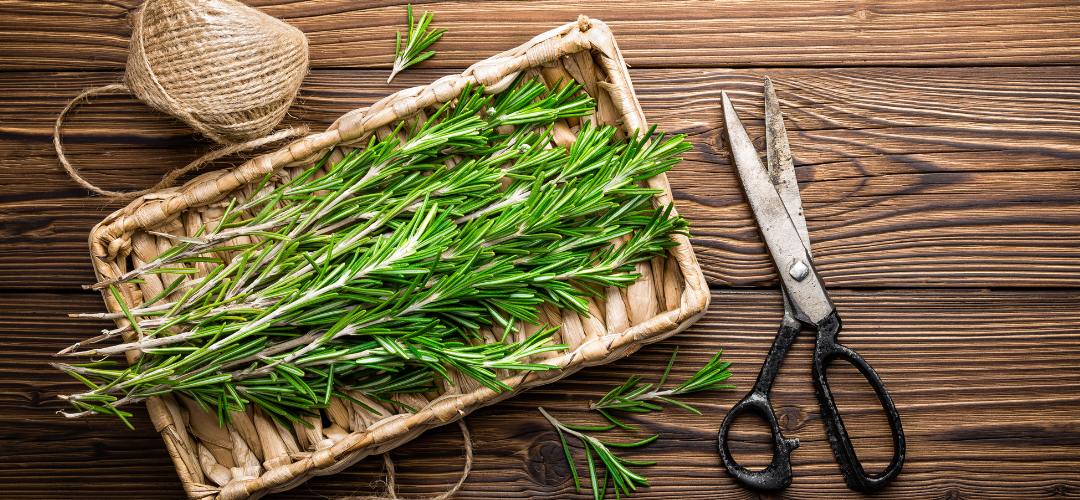Because I’ve used this herb in almost every garden I’ve designed, I’m sharing these ten great uses for rosemary to encourage my clients—and you—to use rosemary as more than just a beautiful plant in the garden. Since you can also just grab some rosemary at the grocery store, you can make use of rosemary even if you don’t have it growing in your garden.
Read on to learn ten fantastic uses for rosemary!
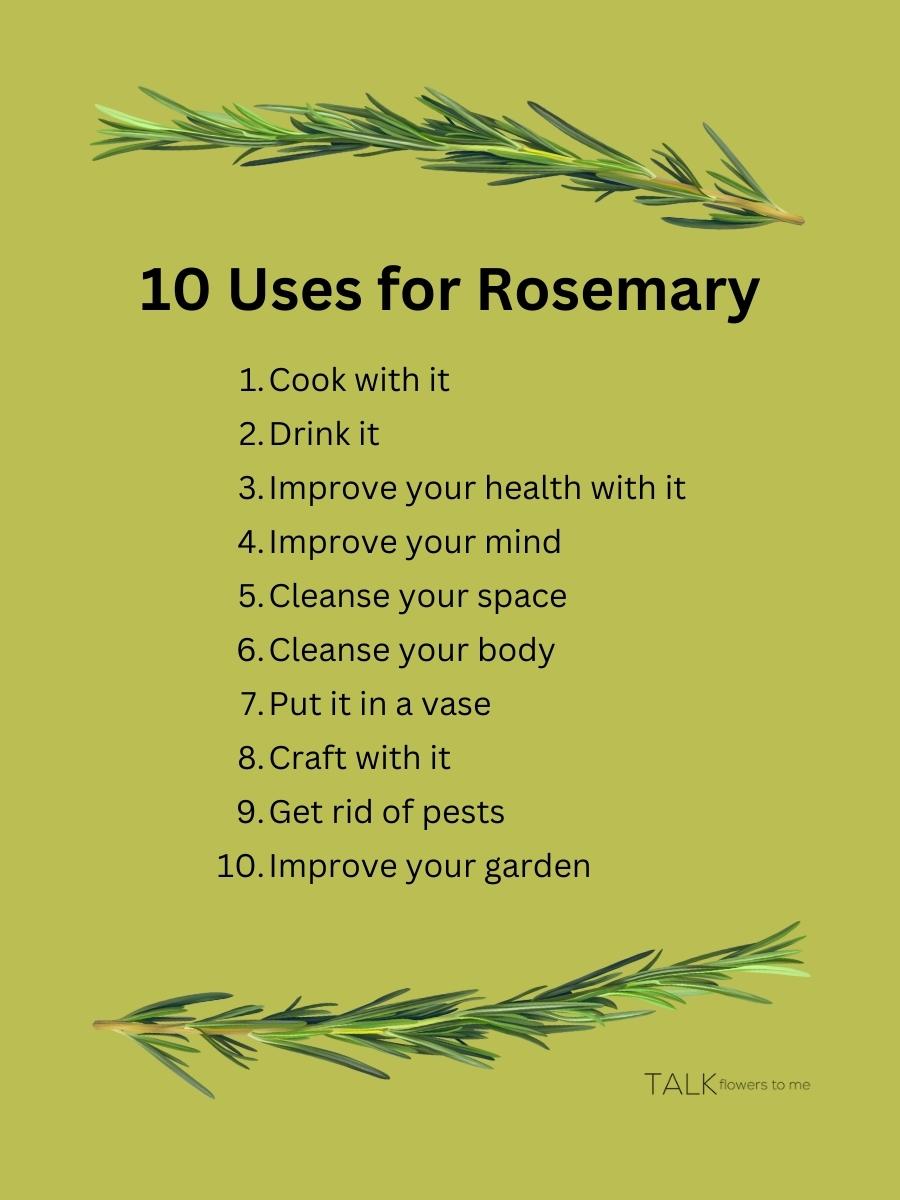
1. COOK WITH ROSEMARY
There seem to be unlimited culinary uses for rosemary.
- It’s perfect for seasoning lamb, poultry, steak, pork, or oily fish dishes.
- It’s used in soups, casseroles, salads, and stews.
- It goes well with potatoes, onions, mushrooms, grains, roasted vegetables, and breads.
- And it’s lovely simply added to salt or infused in olive oil.
The list goes on!
For the basics, my kids enjoy fried rosemary, rosemary potatoes, and roasted rosemary chicken.
While all rosemary could be used in the kitchen, the more aromatic upright rosemary is the type we typically cultivate as herbs. Check out our upright rosemary guide to find the best culinary rosemary for your garden.
If you’re buying rosemary to consume, make sure it was grown for that purpose. You don’t want any added pesticides in your meal!
Fried Rosemary
Yes, fry those leaves in some olive oil. Alice Waters turned me onto this in her Master Class on cooking. She also has a recipe at her restaurant Lulu in Los Angeles, where she uses the fried rosemary on homemade potato chips. Yummmm.
Fried rosemary adds a lovely crunch to just about anything. You can add it to your butter board, your salad, your turkey sandwich! My kids will snack on fried rosemary pieces.
Here’s the recipe from Waters’ cookbook, The Art of Simple Food II:
“Remove the leaves from a medium sprig of rosemary. Discard the stem. Heat a small heavy-bottomed pan over medium-high heat. Pour in about 1/2 inch olive oil. When the oil is hot, add the leaves. Don’t be surprised: the oil will bubble up when the leaves are added. Let them fry for 1 minute and then scoop out with a slotted spoon or fine strainer before they turn brown. Drain on an absorbent paper or towel. Sprinkle with salt and a tiny pinch of cayenne, if desired. They will stay crisp for a few hours.”
2. DRINK ROSEMARY
A lot of rosemary drinks will need a rosemary simple syrup. This is NOT HARD! Just simple steps with three simple ingredients.
Rosemary Simple Syrup Recipe
1 cup water
1 cup white sugar
¼ cup rosemary leaves
(The 1:1 ratio makes things easy!)
Step 1: Bring all the ingredients to a boil in a small saucepan, stirring until the sugar dissolves. Let it simmer for a minute then remove from heat and let it cool.
Step 2: Let syrup steep for 30 minutes.
Step 3: Pour the syrup through a mesh sleeve to remove the rosemary and into a glass jar for storing in the refrigerator. The syrup should last about one month.
You now have your lovely rosemary simple syrup. Now add it to lemonade, or mix with freshly squeezed lemons and vodka, or create a rosemary mojito! Don’t forget to garnish with . . . rosemary.
3. IMPROVE YOUR PHYSICAL HEALTH WITH ROSEMARY
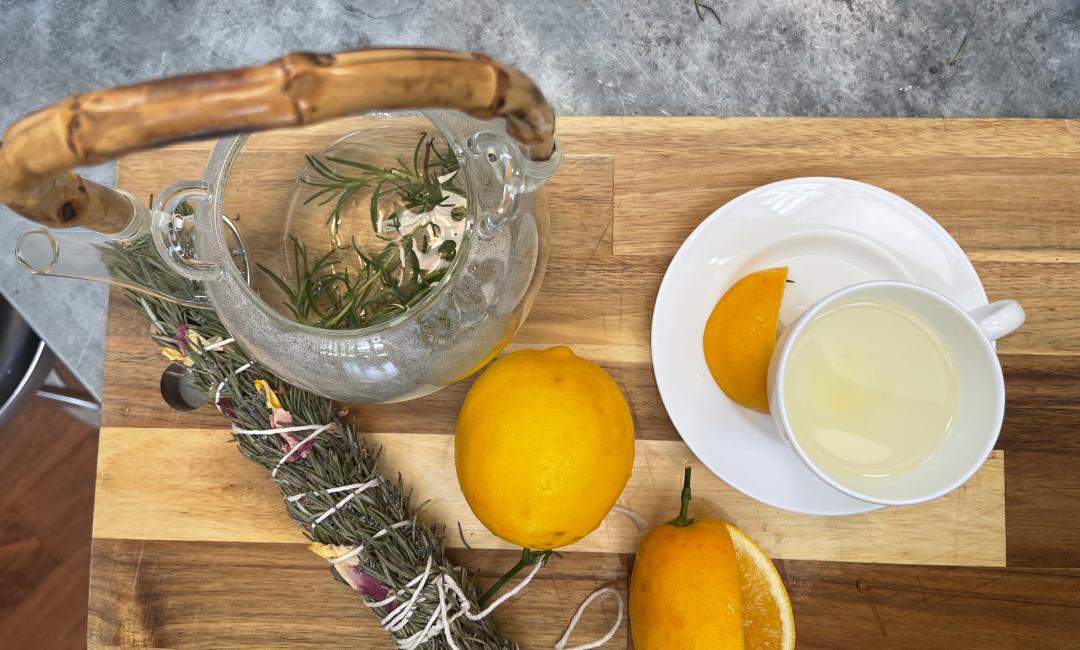
The medicinal properties of rosemary are numerous, including:
● Improved circulation
● Reduced inflammation
● Pain relief
● Improved liver health
● Improved digestive health
● Rosemary is said to soothe the scalp and stimulate hair growth
Taken internally, rosemary is said to improve digestive health by soothing the muscles of the digestive tract. Rosemary tea is also taken as a tonic for calming nerves and used as an antiseptic. Be careful though! It’s also said that ingesting large amounts of this herb can have the opposite effect and irritate the stomach.
Rosemary Oil for Hair
2015 scientific studies have compared rosemary oil to minoxidil. Minoxidil is a popular hair regrowth treatment. People with DHT-related hair loss as well as with androgenetic alopecia used either rosemary oil or minoxidil for 6 months. At 3 months, neither group had more hair. By 6 months, both groups saw significant increases in hair growth.
A 2022 article in Popular Science stated that “hair growth influencers have tried to keep it simple by focusing on one basic ingredient: rosemary.” This is because rosemary is said to soothe and stimulate the scalp, and help with hair growth. Just check out TikTok on the matter and you will see that it is a BIG THING right now.
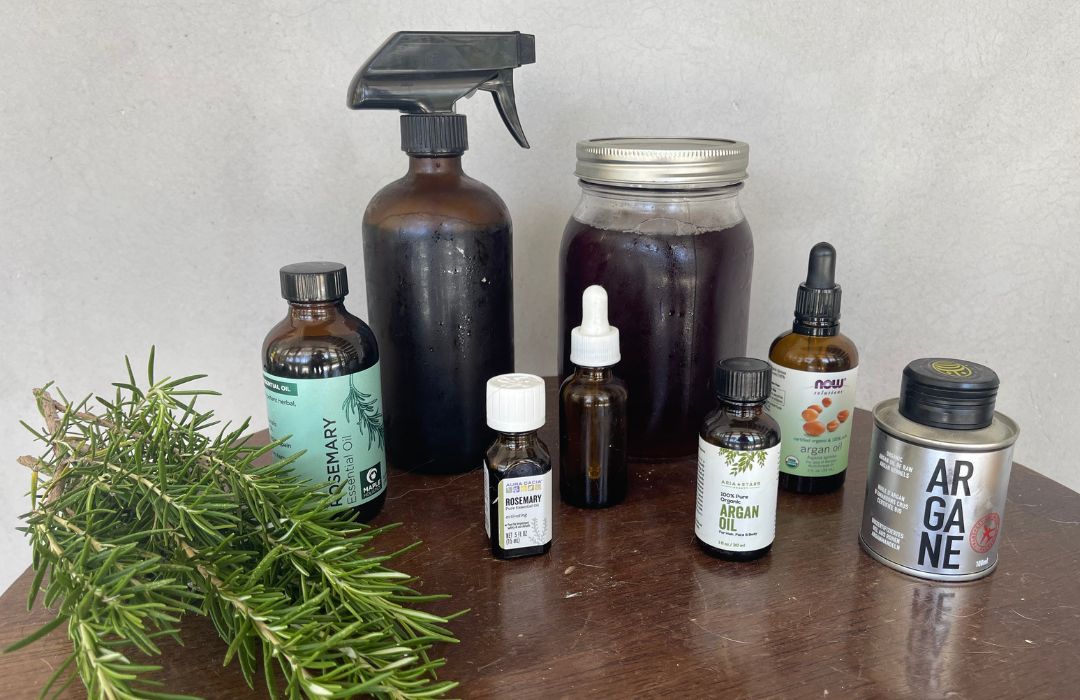
Simple Rosemary Oil Recipe
Step 1: Wash sprigs of fresh rosemary in cold water. Remove the leaves until you have 1 cup. This takes a while.
Step 2: Add rosemary and 2 cups of sunflower, safflower, or olive oil to a saucepan and heat the mixture on low heat for 5-10 minutes. You can also use jojoba oil or sweet almond oil.
Step 3: Strain the oil and pour into a glass container. You can store in a dark place, but I prefer to store the oil in the refrigerator because it helps it last longer.
You can also purchase some rosemary oil and then mix it with a carrier oil, like coconut oil or argon oil, before massaging into your hair. When using store bought rosemary oil, a few drops go a long way.
I often use my rosemary water for a quick rosemary oil by adding the rosemary water to a carrier oil.
4. IMPROVE YOUR MENTAL HEALTH WITH ROSEMARY
Rosemary helps:
- Relieve stress and anxiety
- Improve cognition/help with memory
- Improve mood
- Clear the mind
Simply inhaling the aroma of rosemary can lower levels of the stress hormone cortisol in the body. It’s no wonder rosemary is commonly used in aromatherapy. Its ability to calm the body while energizing the mind is a perfect combination.
Rosemary Water
Yes, just rosemary and water will bring you many benefits. You can start reducing your stress while you make your rosemary water—the smell of rosemary will fill your kitchen.
Want to add the aroma of rosemary to your bath? Pour some rosemary water in it.
Here’s how to make and enjoy rosemary water.
5. CLEANSE YOUR SPACE WITH ROSEMARY
Make a rosemary cleansing stick! Burning herbs like rosemary is said to not just aid in relaxation, but also to drive out negative energy. Burning rosemary is also associated with creating a fresh start. A 2007 scientific study found that medicinal smoke reduces airborne bacteria—purifying and disinfecting the air.
Note: Rosemary cleansing sticks might not stay lit as well as the traditional smudges made of white sage. They also have a more subtle smell and a less overpowering waft.
How to Make a Rosemary Cleansing Stick
To make your rosemary herb stick, all you need to do is tie a few sprigs of rosemary together and wait for them to dry.
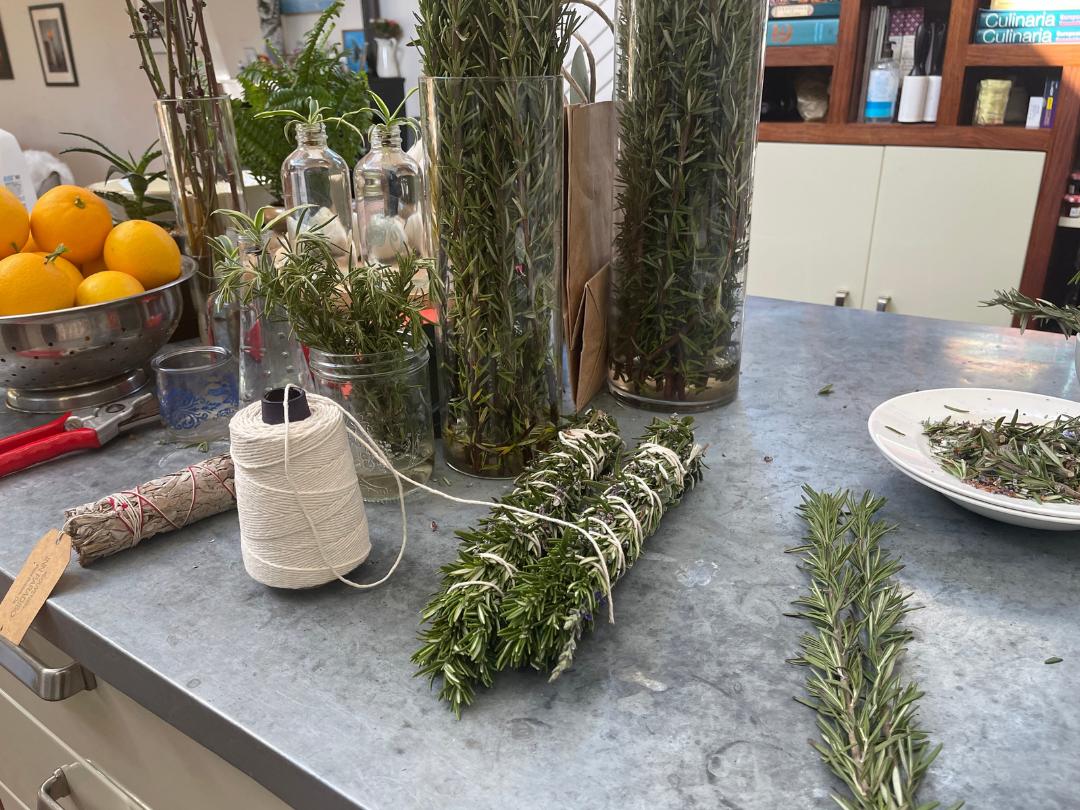
Here’s what to do:
- Prep ‘em: Gather and rinse off your fresh rosemary. Let it dry. You want it to be fairly fresh, otherwise the rosemary will just crumble when you tie it together.
- Group ‘em: Group about 10 rosemary stems of the same length, stems down. Or, cut them to the size you want and group them together. You can enhance your rosemary wand by adding a few other herbs and plants like lavender, roses, sage, lemon grass, juniper, or cedar.
- Secure em’: Take twine or cotton string and secure the bottom of the stems together then circle up and back down the stems of rosemary, wrapping them tightly. Tie again at the bottom.
- Hang em’: Hang the wands in a dry, dark place. The thicker the bundle, the longer it will take to dry. In general, you can assume it will take about three weeks.
- Use em’: Light it up with a match. If it doesn’t fizzle out, go ahead and wave it out.
The burning of plant material for health, balance, and cleansing is an ancient practice that’s been used throughout history by many cultures.
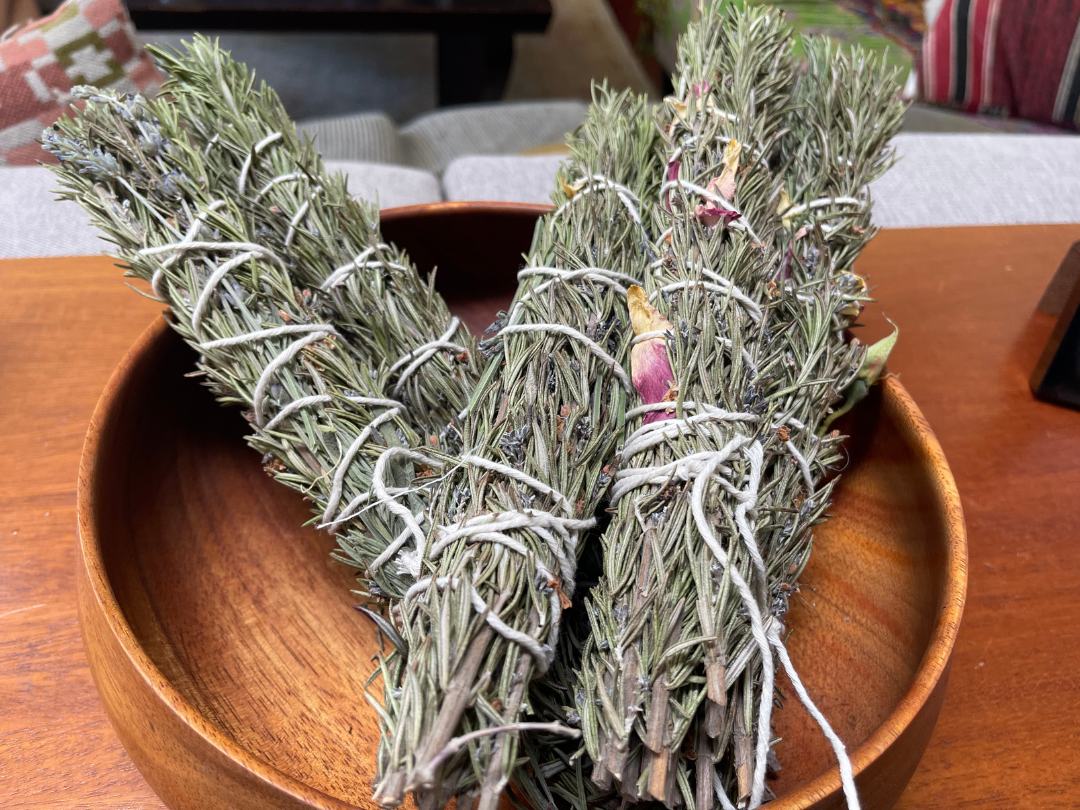
It needs to be noted that the practice of smudging is considered sacred medicine to many Native American/Indigenous Nations. I try to avoid the word “smudge” with the herb bundles and acknowledge I have very limited understanding of the ceremonial ritual of smudging. If you would like to try using a traditional white sage, ethically source it from a seller like Mojave Moon Apothecary.
6. CLEANSE YOUR BODY WITH ROSEMARY
Other uses for rosemary? Beautifully scented soaps, shampoos, and bath products. All of which you can make yourself.
Super-Quick and Easy Rosemary Bath Salt Recipe
Mix Epsom salt, baking soda, and dried rosemary leaves for a relaxing and aromatic addition to your bath time routine.
7. PUT ROSEMARY IN A VASE
Rosemary is lovely and long-lasting foliage in a floral arrangement. Check out the photos below for inspiration on some uses for rosemary as a bouquet.
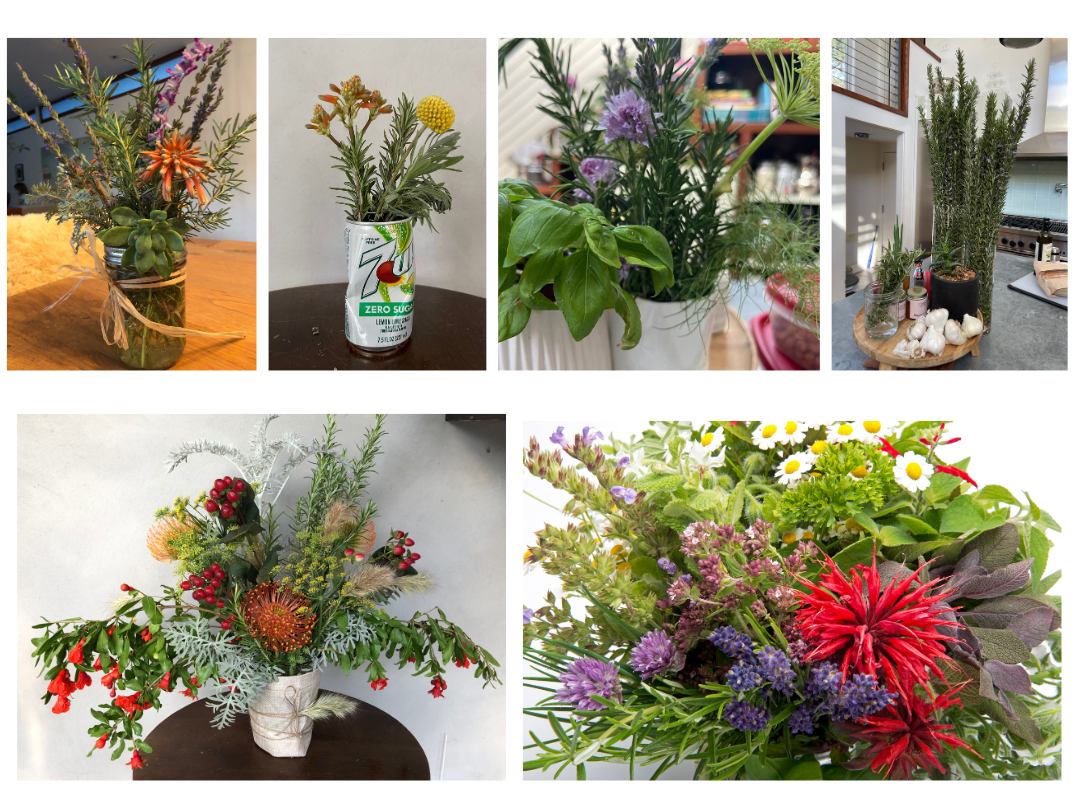
8. CRAFT WITH ROSEMARY
Rosemary uses extend to crafting! There are many projects you can use rosemary with, including making wreaths, decorating gifts, and adding sprigs to your place settings.
Down ‘n Dirty Rosemary Wreath
Step 1: Gather some rosemary and rinse it off. (This isn’t THAT dirty.)
Step 2: Find a round container in your kitchen, and evenly layer the rosemary along the interior.
Step 3: Tie the pieces together with whatever you have, hemp twine, dental floss . . . Add as many ties as it takes to keep the wreath intact.
Step 4 (optional): You can leave the rosemary wreath simple, but you can also add dried flowers or herbs. Rosebuds, which like rosemary are a symbol of remembrance, add a nice touch. And roses always look beautiful against rosemary. You can also add holiday touches like pinecones and red berries.

9. GET RID OF PESTS WITH ROSEMARY
In your closet, rosemary helps deter moths. Use the dried leaves as potpourri and in sachets to scent clothes.
I’ll often put my rosemary water in the closet when the water is extra smelly (in a nice way) but too old for other uses.
Rosemary also repels mosquitoes and flies. Just grab that rosemary oil or rosemary water you made and spray it on your body! Or place a bowl of rosemary in water in the kitchen as a fly deterrent.
In the vegetable garden, rosemary helps to deter cabbage moths, bean beetles, and carrot flies.
10. IMPROVE YOUR GARDEN WITH ROSEMARY
There are many varieties of rosemary. Some varieties are prostrate ground covers, some are very upright and others arching. Some, like Roman Beauty Rosemary, are a mixture of forms.
This makes rosemary an incredibly versatile plant! You can put it work as a ground cover, as the edging of a planting bed, for hanging over a wall, or for forming a hedge.
The list of companion plants for rosemary would basically be the plants in the prototypical Mediterranean garden. It grows beautifully with Lavender (Lavandula), Roses (Rosa) Lemon (Citrus), Bay Laurel (Laurus), Pomegranate (Punica), and Olive (Olea).
I like to plant rosemary with succulents, phormiums, sages, and lantana.

In the garden pictured above, I used a ground cover rosemary at the base of the citrus and upright rosemary to create rooms within the garden.
In a vegetable garden, rosemary adds structure and is grown as a companion plant for cabbage, beans, carrots, and sage. A companion plant, in this case, is one that repels the insects that often attack these plants.
Rosemary is endlessly useful.
To learn more, grab our free list of 101 uses for rosemary.
SOME GOODS TO GET
Get Alice Waters’ brilliant cookbook—the one with the fried rosemary recipe I shared earlier. You’ll be glad you did!
I also recommend checking out Alice Waters’ Master Class on The Art of Home Cooking. (Or just browse the full Master Class catalog, which includes loads of classes on food, wellness, gardening and so much more.)
We partner with select companies whose products and/or services we love. Some of the links on this page may be affiliate links. If you purchase an item using our affiliate link, we may receive a small commission (at no added cost to you). We appreciate your support.

